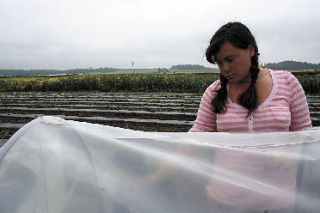If farming isn’t exactly booming on Whidbey Island with agricultural land at a premium, the cross section of stakeholders at Monday’s Whidbey Family Farms forum displayed not only a willingness but a desire to light the fuse.
The second annual forum drew over 100 interested parties, including a strong contingent of farmers already doing their part to keep agriculture alive on Whidbey, interested citizens, and an inordinate number of elected officials and candidates for office.
The latter group’s attendance was appropriate as the forum sought to explore the importance of farmers and local government working together toward the same goal. Whether it be regulatory issues, marketing concerns, or distribution, the governmental presence showed the politicians’ support for agriculture.
Last year’s forum revealed a need for solidarity among farmers, regardless of the respective production size, and pooling resources to provide the “growth” industry a boost. Government is one cog in the wheel. Building solidarity among farmers and pooling resources is meant to give the “growth” industry a large boost.
Through its forums and the formation of work groups, in addition to other efforts, the Whidbey Sustainable Agriculture Committee engages the community in forward-thinking dialogue that will ultimately produce solutions. The WSAC, formed in 2004 as a loose group of like-minded ag proponents, grew into itself and after more clearly defining its purpose, last year launched its mission.
Karen Bishop, Water Conservation and Sources work group member, said farmers are all searching for their niche, regardless of production size. With Whidbey’s unique cross-section of residents and its varied geography, solid, well-laid out plans are critical.
Each work group dissects a separate area. Using different methods, the efforts are helping Whidbey establish its industry presence through meat processing, branding, agri-tourism and other means.
Snohomish County has been a success story in building a solid ag industry. And the key to its success is the partnership with local government. The Northwest Agriculture Business Center provides a cornucopia of client services to farmers. NABC Executive Director David Bauermeister said a large part of improving economic viability is consumer education.
“The best food is the food that comes from closest to home,” he said, recommending the formation of a sub-committee to promote locally-grown ag products. “The good news is there’s a lot of consumers that are finding that out.”
Partnerships have kept the nonprofit corporation alive and providing business resources and hands-on guidance to farmers in Island County and other regional jurisdictions. Operating and project funds are provided from state and federal budget resources, private foundations, sponsorships, project income, and client reimbursement.
Central Whidbey farmer Georgie Smith, owner of Willowood Farm of Ebey’s Prairie, said a farm tour driving brochure is being developed to identify farms in Ebey’s Landing, where her very recognizable historic farmstead resides.
“It’s a way to make connections,” said Smith, whose organic produce can be found in local restaurants and weekly at the Coupeville Farmers Market. “It puts farming on display. That’s what rural farming is all about, connecting with the people.”
Linda Nuenzig and Mark Craven, both Snohomish County farm owners, described the watershed taking place in their county. Nuenzig said a proactive agriculture action plan, birthed after an 18-month gestation period, is turning ideas into reality.
“It was a long time coming,” she said. “We couldn’t have done it without elected officials backing it.”
Bob Gore, acting director of the state Department of Agriculture, said his agency has been using money doled out by the Legislature to hold diagnostic focus groups all over the state. The ultimate purpose is to generate a strategic plan to present the Legislature. In 1989 the department underwent the same process, but Gore said the plan became “shelf art.”
He also said the department is working with the Office of Superintendent of Public Instruction to get local, healthier food into schools.
“Local farms, healthy kids,” he said.
Bishop, Whidbey Conservation District manager, emphasized that, although farmers value their independence, developing partnerships is the key to survival and prosperity.
While he acknowledged Snohomish County’s success, Island County Commissioner Phil Bakke was concerned that local, ongoing ag efforts were largely ignored.
“The board of commissioners has put a huge emphasis on agriculture since 1996 when we first worked on Growth Management Act regulations,” he said after the meeting. The GMA regulations included allowing properly zoned farmland to be subdivided to “carve out small chunks of family farms” that help raise capital and present the option of building a home on the land.
“We also allow farmers with ag-zoned land to transfer rights and/or density to other properties in their holdings,” Bakke continued. “In fact, Ron Muzall just finished doing one such application wherein permanent conservation of some of his ag holdings were exchanged for allowing greater commercial opportunities for mini storage north of Coupeville.”
The commissioner said he would like to see a future meeting with the county and other local partners that would act as a first step in determining how to protect agriculture and increase its financial viability.
“There is more to do and preserving our farm and forest land is essential to preserving our sense of rural character,” Bakke said.
He’s working with the Economic Development Council and county departments to look at infrastructure that might be crucial to support farming.
One possible example presented Monday was animal processing.
“I think that we can make a case for spending some of our infrastructure money on these types of projects,” Bakke said.



